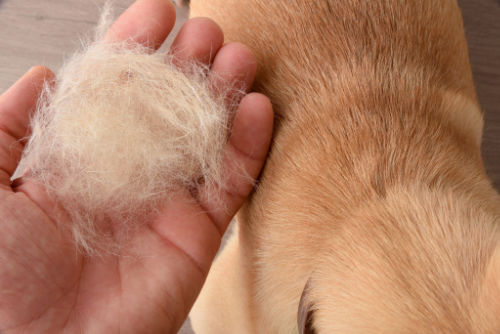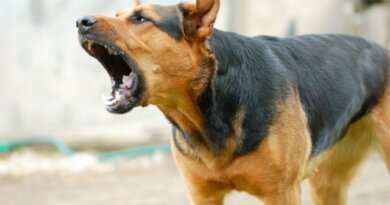10 Mixed Dog Breeds That Don’t Shed – Top Dog Tips
Sadly, some of us dog lovers struggle to find the perfect pet because of allergies.
Many dogs excessively shed, which gets worse during different seasons.
Thankfully, many mixed dog breeds shed minimally.
Why Do Dogs Shed?
Technically, all dogs shed, even those with limited hair.
It is normal for the fur to shed naturally, just like the hair on top of our heads shed daily.
Shedding is natural and keeps their skin and coats healthy, which prevents infections and rashes.
Some dog breeds frequently shed throughout the year, while others shed so lightly you barely notice the fur!
Many people are allergic to dogs and cats, but it is not because of their fur.
Instead, dog allergies are likely because of the dander (dead skin) that flakes as they scratch and shed.
10 Common Mixed Breed Dogs That Don’t Shed
If you have allergies, this does not mean you can’t adopt a dog, but you do have to be pickier. While no dog is 100% hypoallergenic, there are dog breeds that shed minimally and produce less dander. Listed below are six common mixed breeds that don’t shed often.
Goldendoodle (Golden Retriever + Poodle)
Most Goldendoodles take after their Poodle parent with curly and wavy thick fur. Don’t let the length and thickness confuse you; they don’t shed a lot!
Goldendoodles are the perfect pet for those of us with pet allergies.
However, while they are advertised as hypoallergenic, no dog truly is!
The thing about Goldendoodles is that their Golden Retriever parent does shed a lot, but this does not mean they will inherit this trait.
Usually, they don’t!
However, if your pet does shed a lot, you can always take them to the groomers frequently and find products that are easy to clean.
Yorkiepoo (Yorkie + Poodle)
While Yorkiepoos are mixed with a Poodle, they are small designer dogs.
These small designer dogs are mixed with a Yorkie parent and a miniature poodle parent.
They often inherit a low-shedding coat from their Poodle genes and their size from their Yorkie parents.
While this mixed breed dog rarely sheds, they require plenty of care and grooming.
Some Yorkiepoos have naturally curly fur, while others have silky hair you can run your hands through without getting stuck.
Daily brushing is recommended to prevent mats and remove shedding fur before it hits the ground.
Shih-poo (Shih-Tzu + Poodle)
The Shih-Poo is another Poodle mixed breed that is a low-shedder. Shih-poos are a mixed breed with no shed and a Shih-Tzu parent.
Not all Shih-poos look alike, but if you get one breeder have bred with other Shih-poo generations, they likely have light, thin, and straight fur that grows quickly.
Shih-poo puppies almost don’t shed at all but require trims.
They have long fur that can limit their sight as it falls in front of their eyes.
Morkie (Maltese + Yorkie)
The Morkie mixed dog breed looks a lot like a stuffed animal.
These teddy bear look puppies are a small dog breed and rarely shed!
Usually, one parent is a Maltese, while the other is a Yorkie.
However, reputable breeders with years of experience breed multi-generational Morkies to increase health and perfect their low-shedding coats.
These puppies have hair instead of thick fur.
Instead, like the Shih-poo, vets recommend frequently trimming their fur not to bother their eyes.
It is hard to see with long hair and can scratch your dog’s eye and introduce bacteria.
Cockapoo (Cocker Spaniel + Poodle)
Another Poodle mix makes the list! Cockapoos are sweet pets with gentle giant energy. They are loving and affectionate, the perfect family dog.
Even better for those of us with allergies, Cockapoos shed lightly and don’t produce frequent dander.
Instead, they take after their Poodle parent with non-shedding fur but a high-maintenance coat.
Regardless of what breed your Cockapoo takes after, they will need a lot of grooming.
Brushing their coats daily as the curls or waves tangle with time is important.
Knots are difficult to take care of, especially with anxious dogs.
Always take your Cockapoo to the groomer once every 5-6 weeks to trim their coats.
Chiweenies (Chihuahua + Dachshund)
As a proud dog mom of three Chiweenies, these adorable pets are a favorite in my household because of their funny ears and lack of shedding.
However, not all Chiweenies are light shedders, depending on who they inherit their genes from.
Most Chiweenies have short fur that is thin.
As long as you care for their skin and coat, it is rare for them to produce dander, scratch excessively, and shed.
However, some dachshunds have long fur, which Chiweenies can inherit.
If they inherit this trait, it does require additional daily brushing to prevent knots.
Labradoodle (Labrador Retriever + Poodle)
Since most Labradoodles inherit their Poodle parent’s curly and minimally shedding fur, it is unlikely you will have a shedding problem.
However, Labrador Retrievers shed frequently, depending on the mixture.
Labradoodles are medium-sized dogs and grow between 21 to 24 inches tall.
They are a great mixed-breed dog for families with small children since Labradors are natural protectors.
Poodles need exercise and are high-energy, but they nap most of the day.
The good thing about Labradoodles is even if it does shed, you can always brush their fur daily with a shedding comb to decrease the amount of fur on the floor.
Schnoodle (Schnauzer + Poodle)
You may have noticed a pattern on this list.
Many of the non-shedding mixed breeds are mixed with the Standard Poodle.
Schnoodles are no different and are a mix between a Schnauzer and a Poodle.
Interestingly, Schnauzers are a low-shedding dog breed with a double coat.
Like Poodles, you do need to brush their fur daily and give them trims.
Berdoodle (Saint Bernard + Poodle)
The Berdoodle, also called the Saint Berdoodle, is a mixed-dog breed that sheds minimally.
Even though most Berdoodles have a fuzzy appearance, they rarely shed excessively.
Their fur instead protects their skin.
Their coats are also low maintenance if they take after their Saint Bernard parent.
But if your Berdoodle has a curly coat, you will need to untangle it daily to avoid knots.
Trimming the fur is just as important as the growth can leave your dog with covered eyes.
Bullmatian (Bulldog + Dalmatian)
Every time I see a picture of a Bullmatian, I cannot help but smile.
This mixed-dog breed is unique because almost all Bullmatians have the same spots and coats as their Dalmatian parent.
Dalmatians are known for being low-shedding dogs.
Bulldogs shed frequently, but rarely do Bullmatians inherit this trait from their parents.
They are affectionate pets and great for families with children since they are loyal and calm dogs.
Dog Shedding Tips and Tricks
Whether you adopt a low-shedding dog or not, there is still a chance that dander and fluff will fly throughout your home and coat your floors.
There are many ways you can control your dog’s shedding.
While you can’t stop them from shedding, you can help them release hair and fur with the proper tools.
Dogs, with time, start to smell.
Their fur, dander, and saliva produce the odor, making your home smell like your dog.
Once you get rid of the excess fur on the ground, the smell usually goes with it.
Brushing Daily
Always check in with your dog’s vet. Not all mixed breeds require daily brushing, especially if they are low shedders with short and thin fur.
However, mixed breeds like the Corgipoo and the Shih-poo need daily brushing.
Their long fur and hair sometimes drag on the ground moving fur and dirt, which gets trapped in their long locks.
Detangling brushes mixed with water and dog-safe conditioner do the trick!
For dogs that shed a lot, like Corgi mixes, brushing their fur daily helps since they are heavy shedders.
When you brush them out, their fur will clump on the brush; simply throw it away or vacuum the area when done!
Washing Your Dog
Bathing your mixed breed dog is super important to their skin and coat health.
While shedding is normal, if your dog is excessively shedding to the point where they are losing chunks of fur, it could be a sign of a health condition or poor skin health.
When bathing your dog, make sure to scrub thoroughly.
I like to also brush my dogs as they are wet with soap to get rid of knots and shedding fur.
Bathing your pet frequently also reduces the amount of dead skin and hair they shed throughout your home.
Vacuuming Carpet Daily
All floors collect fur and dander, but carpet and rugs are the worst!
The small fibers on these floor types make your pet’s fur and dander disappears.
It is hard to see unless you stick your head on the floor to look for the fur and hair.
If you have a mixed-breed dog that sheds a lot, it may be time to look for a high-quality pet fur vacuum.
These vacuums are strong and suck up even the smallest of fur on your carpet.
Sometimes, fur, dander, and hair collect in the corners of the room right against the wall because of the air conditioner or fan.
You can purchase a thin vacuum attachment to suck up the area, get a broom, and brush the fur out of the corners.
Some people also recommend using baking soda, a common household ingredient, on the carpet to remove the small pieces of fur.
Mixed Dog Breeds That Don’t Shed: Conclusion
In conclusion, fur and dander can affect a person’s allergies, but not all dogs shed or produce dander a lot.
Instead, some allergy-friendly dogs are available, like the Yorkiepoo and the Morkie.
Poodles are a great breed if you want to see less fur throughout your home.
Related





